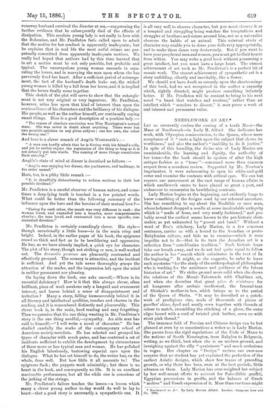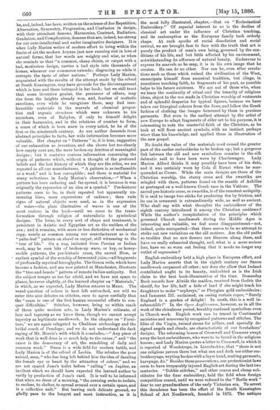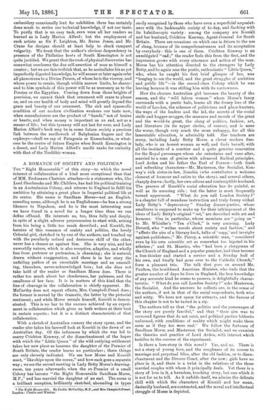NEEDLEWORK AS ART.*
LET us reverently confess the coming of a tenth Muse—the Muse of Needlework—in Lady M. Alford. She dedicates her work, with Olympian condescension, to the Queen, whose mere acceptance of it " casts a light upon the subject that shows its worthiness," and also the author's " inability to do it justice." In spite of this humility, the divine airs of Lady Marion are unmistakeable, the learning and . dignity, the authority of her tome—for the book should be spoken of after the high antique fashion as a " tome"— command more than common respect from a mundane review. Supported by Mr. Newton's imprimatur, it were unbecoming to open its white-and-gold cover and examine the contents with critical eyes. We can but express our amazement at the vast range of human affairs in which needlework seems to have played so great a part, and endeavour to summarise its bewildering contents.
Lady Marion begins at the beginning, and evidently longs to know something of the designs used by our arboreal ancestors. She has something to say about the Neolithic or cave man, whose helpmeet dropped a needle at some incalculable antiquity which is " made of bone, and very neatly fashioned," and pro. bably sewed the earliest seams known to the pre-historic shirt- maker, as yet unhaunted by " gusset and band." Without a word of Eve's stitchery, Lady Marion, in a few sonorous sentences, carries us with a bound to the Accadian or proto- Babylonian culture, and bids us to surmise—which it were impolite not to do—that in its turn the Accadian art is a reflection from " antediluvian tradition." Such historic leaps take our breath away, and we do not feel quite equal to follow the author in her "search which culminates in the text of In the beginning." It might, as she suggests, be safer to leave such mysteries "for the study of the anthropological philosopher who is working for the assistance and guidance of the future historian of art." We strike ground more solid when she shows the relations of the Mosaic Tabernacle with Chaldean art, and when she describes that great piece de resistance for all hungerers after archaic needlework, the funeral-tent of Shishak's mother-in-law, which brings us to the period of the Queen of Sheba. " It may be described as a patch- work of prodigious size, made of thousands of pieces of gazelles' skins, dyed and neatly sewn together with threads of colour to match, resembling the stitching of a glove, the outer edges bound with a cord of twisted pink leather, sewn on with stout pink thread."
The immense field of Persian and Chinese design can be but glanced at even by so conscientious a writer as is Lady Marion. She passes from the rigid regulations of the Code of Mann to the notions of South Kensington, from Babylon to Belgravia, writing, as we think, best when she is on modern ground, and inveighing against the silly " quaintness " and mock archaisms in vogue. Her chapter on " Design " revives our ever-new surprise that no student has yet explained the perfection of the earliest Asiatic designs, which show few traces of preceding growth, or why there has been, even at the best periods, little advance on them. Lady Marion has over-weighted her subject by her well-meant efforts to account for Palaeolithic graffiti, Egyptian processions in profile, and the balance of Greek " motive" and Greek expression of it. More than one tome might • liasoletcork as Art. By Lady Marion Alford. London : Sampson Low and Co. 1886. be, and, indeed, has been, written on the science of due Repetition, Alternation, Symmetry, Progression, and Confusion in design, with their attendant demons, Harmonies, Contrast, Radiation, Gradation, and Complication, demons that are, indeed, too strong for our over-intellectual and under-imaginative designers. It is when Lady Marion writes of modern effort to bring within the limits of art the modern Aryans just now running riot in love of natural forms, that her words are weighty and wise, as when she reminds us that "a common, cheap chintz, or carpet with a bad, motiveless design, carries a bad style into thousands of homes, wherever our commerce extends ; disgracing us while it corrupts the taste of other nations." Perhaps Lady Marion, acquainted with the results of the attempt made by the school at South Kensington, may have grounds for the discouragement which is here and there betrayed in her book ; but we still trust that some inventive genius, the precursor of others, may rise from the heights already won, and, fearless of assthetic sanctions, even while he recognises them, may find inex- haustible materials in the marvels of chemical propor- tion and organic structure which were unknown to his ancestors, even of Babylon, if only he himself delight in their harmonies, and in the relations of number to form, a sense of which is born anew in every artist, be he of the first or the nineteenth century. As our author descends from abstract principles to facts, her wide information becomes more valuable. Her chapter on " Patterns " is, it is true, suggestive of our exhaustion as inventors, and she shows but too clearly how empty ours are, the mere broken-up detritus of meaningful designs ; but it contains curious information concerning the origin of patterns which, without a thought of the profound beliefs and the lost history of which they are the relics, we see repeated in all our manufactures. "A pattern is as ineffaceable as a word," and is less corruptible ; and there is material for many reflections in Lady Marion's observation,—" When a pattern has been enduring and far-spread, it is because it was originally the expression of an idea or a symbol." Pre-historic patterns seem to be, in their repeated but apparently un- meaning lines, mere expressions of cadence ; then rude signs of natural objects were used, as in the expression of water—the plate illustrative of waves is one of the most curious in the book—until we come to the trans- formation through religion of naturalistic to symbolical designs. The lotus, in every sort of shape and treatment, is persistent in Asiatic and Egyptian art as the emblem of the sun ; and it remains, with more or less distortion of mechanical copy, nearly as common among our manufacturers as is the "palm-leaf " pattern on shawl or carpet, still witnessing to the "tree of life." On a rug, imitated from Persian or Indian work, may be seen bits of broken-up wave, or key, or honey- suckle patterns, the pre-historic cross, the sacred Horn, or earliest symbol of the worship of fermented juice,—all fragments of profoundly mystical hieroglyphs. The Genoa veils, which have become a fashion, and are now printed at Manchester, illustrate the "tree-and-beasts " pattern of remote Indian antiquity. But the subject tempts us too far afield, and we have not space to glance, however slightly, at the learned chapter on "Materials," in which, as we expected, Lady Marion returns to Manu. The vexed question of colour is best left untouched, nor will we enter into nice debates on stitches, save to agree cordially that the " seam is one of the first human successful efforts to con- quer difficulties." Stitches, however, bring us within reach of those quite modern arts, in Lady Marion's estimate, of lace and tapestry as we know them, though we cannot accept tapestry as legitimate needlework. In the chapter on "Furni- ture," we are again relegated to Chaldean archmology and the bridal conch of Penelope; and we do not understand the dark saying of Mr. Morris's with which it concludes,—" Any piece of work that is well done is so much help to the cause ;" and " the cause is the democracy of art, the ennobling of daily and common work." Dress is a wide field for modern battle, and Lady Marion is of the school of Lesbia. She rebukes the poor animal, man, " who has long left behind him the idea of dazzling the female eye or heart by the attraction of colour," and we are not spared Juno's toilet before " calling" on Jupiter, an incident which we should have expected the learned author to verify by production of Juno's card. It is well to be informed that when we dress of a morning, " the covering seeks to isolate, to enclose, to shelter, to spread around over a certain space, and is a collective unit." But leaving such delicate ground, we gladly pass to the longest and most instructive, as it is
the most fully illustrated, chapter,—that on "Ecclesiastical Embroidery." Of especial interest to us is the decline of classical art under the influence of Christian teaching, and its reabsorption as the European family took orderly shape. At such epochs of social dissolution and social revival, we are brought face to face with the truth that art is purely the product of man's own being, governed by the con- ditions of his life, and but little affected by his environment, notwithstanding its affluence of natural beauty. Endeavour to express its marvels as he may, it is in his own image that he creates. He can do no other. Nor can he, even after revolu- tions such as those which ruined the civilisation of the West, emancipate himself from ancestral tradition, but clings, in sometimes touching faith, to fragments of his past, as possible helps to his future existence. We are not of those who, when we trace the continuity of ritual and the tenacity of religions ideas, object to the use made in Christian worship of vestments and of splendid draperies for typical figures, because we have taken our liturgical colours from the Jews, and follow the Greek fashion of clothing the images honoured by them in precious garments. But even in the earliest attempt by the artist of new Europe to adapt fragments of elder art to his purpose, it is interesting to note the masterful faith of the Christian, as he took at will from ancient symbols, with an instinct perhaps wiser than his knowledge, and applied them in illustration of the new gospel.
No doubt the value of the materials used caused the greater part of the earlier embroideries to be broken up; but a gorgeous link between the old and new symbolism remains in the silk dalmatic said to have been worn by Charlemagne. Lady Marion Alford thinks it may possibly have been of his date, and it was certainly worn by Cola di Rienzi when he mas- queraded as Caesar. While the main designs are those of the Christian worship, the starry cross and the zwastika are mingled with them, patterns found on the mantle of Achilles as portrayed on a well-known Greek vase in the Vatican. The sacred pre-historic cross, or zwastika, is of the remotest antiquity. It is said to image two sticks for producing fire by friction, and its use in ornament is extraordinarily wide, as well as ancient. Who shall say with what thoughts the embroiderer of the eighth century introduced it among the Christian emblems P While the author's recapitulation of the principles which governed Church needlework during the Middle Ages is interesting and valuable, we feel some disappointment—not, indeed, quite unexpected—that there seems to be no attempt to strike out new variations on the old motives. Are the old paths so trodden that no new flowers can blossom along them, and have we really exhausted thought, and, what is a more serious loss, have we so worn out feeling that it needs no longer any outlet of expression ?
English embroidery held a high place in European effort, and Lady Marion asserts that in the eighth century our Saxon needlework surpassed all other ; nor does she allow that Ireland contributed aught to its beauty, undoubted as is the Irish claim to the best book-illumination of the time. Domesday Book records how Alwide the maiden, received from Godric the sheriff, for her life, half a hide of land if sbe might teach his daughters to make " orphreys," or Phrygian gold embroideries; and Innocent III. exclaimed, on seeing certain copes, " Surely England is a garden of delight ! In Booth, this is a well in- exhaustible!" In the Opus Anglicanum, however, as in all the work of the chivalrous period, heraldry confused symbolism even in Church work. English work can be traced in Continental sacristies and museums by recognised patterns and stitches. The lilies of the Virgin, twined stems for pillars, and specially de-
signed angels and clouds, are characteristic of our forefathers' designs. The reforming besom of Cromwell and Cranmer swept away the best embroiderers, who were to be found in the religious houses ; and Lady Marion quotes a letter to Cromwell, in which it is reported of Woodstrope, in Lincolnshire, that " there is not one religions person there but what can and doth use either em- brotherynge, wryting bookes with a fay re hand, making garments, karvynge, ezc." Besides these persecutions, our protectionist laws seem to have irreparably injured English art during the last two centuries. "Gobble stitches," and other coarse and cheap sub- stitutes for the finer embroidery, held the field when foreign competition ceased, until we were reduced to the "Berlin work" dear to our grandmothers of the early Victorian era. To arrest this decadence has been the effort of the South Kensington School of Art Needlework, founded in 1872. The antique embroidery occasionally lent for exhibition there has certainly done much to revive our technical knowledge, if not our taste. 'To purify that is no easy task, even were all her readers as learned as is Lady Marion Alford ; but the employment of such artists as Sir F. Leighton, Mr. Burne Jones, and Mr. Crane for designs should at least help to check rampant vulgarity. We trust that the author's obvious despondency in presence of the Philistine hosts of South Kensington is not quite justified. We grant that the rush of physical discoveries has somewhat overborne the due self-assertion of man as himself a creator ; but we are fain to think that, as he assimilates his as yet imperfectly digested knowledge, he will sooner or later again refer all phenomena to a Divine Person, of whom he is the viceroy, and whose power to create, though within narrow limits, he shares; and to him symbols of this power will be as necessary as to the Persian or the Egyptian. Coming down from those heights of prevision, we cannot think that ornament will cease to please us, and on our health of body and mind will greatly depend the grace and beauty of our ornament. The sick and spasmodic -condition of our modern civilisation weakens our taste now, when manufacturers are the product of "hands," not of brains or hearts, and when money is important as an end, not as a means of life ; but this tyranny will not last for ever, and Lady Marion Alford's book may be in some future society a precious link between the needlework of Babylonian fingers and the orphreys—shall we say of Patagonia or Kamschatka, or what- ever be the centre of future Empire when South Kensington is a desert, and Lady Marion Alford's needle ranks for curiosity with that of the Neolithic woman.




































 Previous page
Previous page